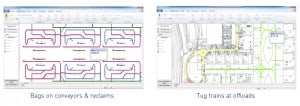While we work with simulations every day in our work with Heathrow, Gatwick and other major and minor airports worldwide, we are aware that not all the stakeholders we deal with have a great understanding of how simulations can benefit them and the terminology that can be used. So, here is the first in a series of occasional blog’s exploring simulations.
The Benefits of Simulation
Using simulations to create airport scenarios allows our clients to make decisions based on real situations. They can visualise their airport or process, as well as any possible changes, and base their decision making on our up-to-date database populated with assumptions, rules and actual data. This includes data on flight schedules, airlines, handlers, vehicles, passenger and more. We can also work with their attitude to risk, and run programmes that will run a situation a multitude of times (a Monte Carlo Simulation) to show them just how often busy periods will occur, for instance.
We can test the functionality and performance of new concepts, before they are put into place. This can save on unnecessary investment, for instance, and time and man power. One example of this is our Stochastic model of a typical day’s activity at Heathrow, used to understand the fluctuations and variations that surround inter terminal coaching. Taking a season’s worth of Big Data, our statistical model collated every flight connection in the airport, along with passenger profiles, coach journeys and more, we were able to show that, instead of adding to their fleet to cope with an increase in operations at Terminal 3, they could simply re-organise their schedule by adjusting other bus routes & frequencies. This freed up vehicles from the fleet to work in busier areas without a negative impact on passenger experience. We were able to prove this using our simulation, allowing the client to have complete confidence in our processes and outcomes.
Transvision AiR
Our experienced technical and simulation team use their skills; such as applied mathematics, gaming theories, statistical modelling and simulation engineering; to create our intelligent simulations, using our bespoke tool, Tranvision AiR.

This enables us to demonstrate the best solution to improve our client’s capacity, to make their operations more efficient and reduce costs. Each simulation is tailored, unique to each airport and it’s processes, and taking full advantage of our up-to-date database and airport knowledge.
We have chosen to develop our own unique simulation tool, instead of using on ‘off the shelf’ to allow us to be flexible and tailored to our client’s needs. Transvision AiR has been derived from first principles, developed to be technically simple, using all our own original concepts and data collected by ourselves. This allows us to create better and more efficient simulations, to the benefit and value of our clients.
As we use 2D visuals, we can demonstrate clarity for plans or live operations that provide cost effective analysis, without the traditional high costs of 3D animation. All stakeholders can see and understand the effect of the change on their individual element, enabling easier stakeholder management and better buy-in.
We are also able to integrate with other simulation tools, such as Simul8, VSSM, AutoMod and CAST, allowing us to work with other teams and forms of data.
For more information about Transvision AiR, look at Our Tools. You can also find out more about the Inter Terminal Coaching Case Study.
Is there anything you’d like to know about simulations and Transvision AiR? A guide to terminology, perhaps, or a look behind the scenes? Let us know

